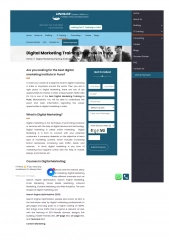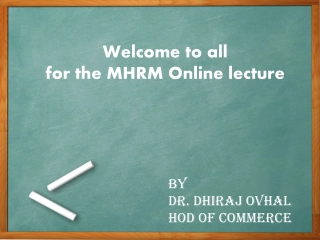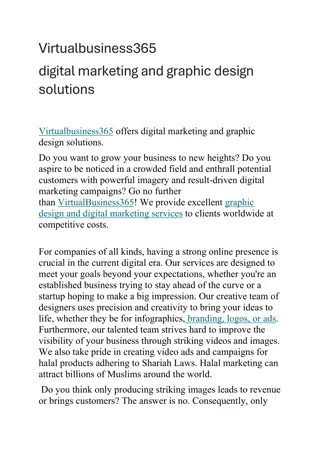
Market Segmentation and Consumer Behavior Strategies
Market segmentation involves dividing the total market into distinct groups of buyers to tailor specific marketing strategies for each segment, ensuring maximum market response. Understanding consumer behavior is crucial for modern marketers in catering to diverse customer needs and preferences effectively.
Download Presentation

Please find below an Image/Link to download the presentation.
The content on the website is provided AS IS for your information and personal use only. It may not be sold, licensed, or shared on other websites without obtaining consent from the author. If you encounter any issues during the download, it is possible that the publisher has removed the file from their server.
You are allowed to download the files provided on this website for personal or commercial use, subject to the condition that they are used lawfully. All files are the property of their respective owners.
The content on the website is provided AS IS for your information and personal use only. It may not be sold, licensed, or shared on other websites without obtaining consent from the author.
E N D
Presentation Transcript
CHAPTER II Market Segmentation & Consumer Behaviour
A] MARKET SEGMENTATION Modern Marketers operate in a few target market, not total market. Markets consist of buyers and buyers differ in one or more respects. They may differ in their wants, purchasing power, geographical locations, buying attitudes and buying practices. Any of these variables can be used to segment a market.
Market Segmentation is an act of dividing the total market into distinct groups of buyers, each of them require a separate marketing mix. The division of the total market for a product into sub-markets is called Market Segmentation. Market Segmentation is a method for achieving maximum market response from limited marketing resources by recognising differences in the response characteristics of various parts of the market.
Market Segmentation is the strategy of divide and conquer i.e, dividing markets in order to conquer them. Its philosophy is something for everybody within limits. Market Segmentation strategy is an answer to the question To whom should we sell our products and what should we sell them? Market Segmentation enables the marketers to give better attention to the selection of customers and offer an appropriate marketing mix for each chosen segment or a group of buyers having homogeneous demand.
Definitions: In the words of William J. Stanton, Market Segmentation consists of taking the total heterogeous market for a product and dividing it into several sub-markets or segments each of which tends to be homogeneous in all significant aspects . According to Philip Kotler, Market Segment is the act of dividing a market into distinct groups of buyers who might merit separate products and/or marketing mixes . In the words of R.S. Davar, Grouping of buyers or segmenting the market is described as Market Segmentation .
Importance of Market Segmentation(Benefits) 1. More precise definition of the Market: Segmentation improves company s understanding of why consumers do or do not buy certain products. He knows adequately about the market. Marketer can formulate and implement marketing plan more successfully. 2. Maximum customer satisfaction: Marketer can cater the needs of customers more effectively. Market segmentation is relevant to the modern marketing practices. It ensures both maximum satisfaction to consumers and maximum sales to the company.
Maximum consumer satisfaction is the master key to solve any problem. Customers can have products as per their needs, they can get better products or services at lower costs. 3. Effective Marketing Strategy: Market Segmentation provides an opportunity to understand needs and wants of different segments of the market. This can help in formulating marketing mix more meaningfully. Company can gain a maximum market response.
4. Essence of Modern Marketing: Market Segmentation strategy fits with modern marketing philosophy. If the marketer wants to satisfy his valued customers, market segmentation is the only option. It is an essential condition for the successful modern marketing practice. 5. Improved Profitability: On the basis of the study on needs of specific group of buyers, the products are manufactured. Company can attract distinct groups of buyers and can increase sales. An increased sale has positive impact on its profitability.
6. Optimum use of productive resources: Market Segmentation leads to effective use of the valuable resources. Resources are allocated and used exactly as per market needs, avoiding mismatching between what marketer offers and what the market needs. So, valuable resources like man, money, material, space, technology, time etc can be utilised more effectively.
7. Benefit of Specialization: It is easy to direct marketing efforts more clearly and specifically. Company designs its marketing programme for different products and for various groups of buyers. Specialisation in production and marketing can offer a lot of benefits to the company. 8. High Competitiveness: As a result of market segmentation a company can treat its consumers more effectively than competitors. It improves competitive strength of the company. Company can respond strongly to the competitor, can prevent the entry of competitors, or can defeat competitors. Company can create and maintain the legal consumers for long period of time.
9. Collection of Valuable Information: Market Segmentation process collects a lot valuable information for the company. Such information is instrumental for marketing research, product development and evaluation of marketing activities. It is also useful for measuring effectiveness of sales and distribution facilities. 10. Identifying Market Opportunity: Market Segmentation establishes close relations with specific groups of buyers. Close relations facilitate a continuous interaction between consumers and company. Consumers inform the company regarding changes in their needs, wants and habits on a continuous basis or whenever asked. It is easy for a market to identify the future trends. Marketer can identify opportunities to be available currently or in the near future and can plan accordingly.
11. Benefits to society and nation: Market Segmentation is a consumer-oriented philosophy and it results into a win-win-win approach that is company, society and nation, all three are benefited. This can improve overall economic system by manufacturing the right products of the right quantity and quality for the right groups of consumers, made available continuously at the right price and place by the right distribution channel.
12. Benefits to small scale industrial units: Small scale units have limited manufacturing and marketing capacity. Industries working on a small- scale basis can take advantages of market segmentation. By concentrating on special demand of specific group of a limited number of consumers, they can afford products and get profitable market easily.
Limitations of Market Segmentation 1. Limited Production: In Market Segmentation, customers are limited. So it is not possible to produce products in mass scale for every segment. Company cannot take advantages of mass scale production. Product may be costly and affect adversely to the sales. 2. Expensive Production: Market Segmentation is expensive in both production and marketing. In order to satisfy different groups or segments of buyers, producers have to produce products of various models, colors sizes etc., that result into more production costs.
3. Difficulty in Distribution: Company needs to make the separate arrangement for each of the products demanded by different classes of customers. Company has to maintain separate channels and services for satisfying varied customer groups. 4. Heavy Investment: Market Segmentation leads to heavy investment. A company has to produce variety of product lines and product items, to satisfy the different needs and wants of various groups. For this purpose, the company requires to invest more on technology, which will require heavy investment.
5. Promotion Problems: Market Segments are made on the basis of distinguished characteristics of buyers. In order to influence various segments of buyers, the company requires to prepare advertising programme. 6. Stock and Storage Problems: To meet the needs and wants of different consumer groups, the company must maintain adequate stock of various products on a continuous basis. This creates problem of stocks, storage and working capital.
Criteria for successful Market Segmentation If the market segmentation is to be successful or effective, certain criteria must be satisfied: 1. Substantiality: Substantiality implies that markets must be larger enough to justify company s marketing efforts. It must offer attractive opportunities in terms of return on investment. Too small segments are not profitable as the firm has to make separate marketing programme for each of the segments.
2. Measurability: The main aim of segmenting the market is to measure the changing behaviour pattern of consumers. Measurement of the changes in the behaviour of consumers is not an easy task. The differences in the consumer s preferences for a product must be identifiable. The variations in consumer behaviour are numerous and complex. But measurement of behaviour pattern is an essential requirement for effective market segmentation.
3. Accessibility: The segmentation should be such that a firm can meet reasonably the expectations of selected segments. Firm must serve different segments efficiently. It must be possible for the marketing managers to focus their attention and marketing efforts in the chosen market segments. If the marketing managers are not able to reach the market segments, the market segmentation will be worthless.
4. Representability: Each market segment must be representative in character and must posses individuality of its own. It should be profitable enough to be considered as an independent market. 5. Adequate/Effective Demand: Different segments must exhibit adequate demand. Each of the selected segments must be able and willing to buy the company s offers.
6. Market Responsiveness: The various market segments must show differences in response to marketing variables or marketing mix. If the various market segments respond similarly to marketing variables, market segmentation will be of no use. 7. Actionability: The segmentation must permit a company to take necessary actions effectively. It must be able to tackle the problems and to absorb available opportunities.
Different variables are used to market segmentation. The buyers may differ in their wants, resources, geographical locations, buying attitudes and buying practices. Any one or more of these variables can be used to segment market. The bases for segmenting the markets may differ from product to product and from firm to firm. The bases for market segmentation may differ for segmenting consumer market and industrial market.
Bases for Market Segmentation Bases for segmenting Industrial Market Bases for segmenting Consumer Market
There can be several bases used for segmenting consumer market. As stated by Philip Kotler, bases can be classified into two categories: 1. People-Oriented Bases 2. Product-Oriented Bases 1. People-Oriented Bases: The main bases in this category include: a. Geographical Bases b. Demographical Bases c. Psychographic Bases
a. Geographical Bases This segmentation is based on places or locations where consumers reside. Market is divided into different geographical units, such as nations, states, regions, cities, climates, urban/village etc. Needs and preferences will be significantly different at different places. A company may operate in one or more geographical areas as per its capacity. Company divides its market in the following segments:
i) Local Market: Here, company operates in a limited area. Local market includes villages, towns or cities. Company concentrates on local needs & preferences such as vegetables, bakery items, local dairies etc. Company operates locally. ii) Urban Market: Here, the company serves urban consumers only. For eg: products used in urban areas like costly furniture, lifts, educational books, specialist doctors, chartered accountants etc.
iii) Rural Market: The products which are dominant in rural areas such as thick cotton clothes, cattle feeds, pesticides, fertilizers etc., In most cases, the rural consumers use cheaper, durable and simple products. iv) Regional or State Market: Certain products are produced and consumed only in certain regions or states. Due to regional culture, tradition, climate, restrictions of regional governments or habits of people. Eg: State Transport Corporation and Regional Education Publications etc.
v) National Market: Certain manufacturers produce and sell the products throughout the nation. Eg: Bata s products, Godrej products etc have national market. vi) International or Global Market: Some products are sold in many countries. Eg: Air India Services, Colgate-Pamolive, Hindustan Unilever, Coca-Cola, Nirma Chemicals etc have got international market.
vii) Climate/Weather: Climate plays an important role in determining the needs of people. Climate is based on cold, heat, hills, jungle, sea, desert etc. Some products are used only in particular climate. Certain products like vehicles, clothes, food, boats, camels, umbrella & raincoats, cold drinks, fans, A/c s etc are used as per their suitability with the climate of specific region.
b. Demographical Bases Demographic means relating to population. In demographic segmentation, the market is divided on the basis of demographic variables such as age, sex, family size, income, occupation etc. This type of segmentation is most popular and widely practiced. It is comparatively easy to identify and measure market by demographic variables. The various demographic bases for market segmentation are:
i) Age: Consumers of different age groups differ in terms of needs, preferences, quantity, interest, habits etc. An individual changes his needs, preferences and habits as he grows from childhood to adulthood. Based on age criteria, the markets are segmented as infants/children, teenagers, youngsters, adults and olds. For the products like chocolates, clothes, cycles and motorcycles, films, books and magazines, foods, medicines, clubs etc, an age-based segmentation seems effective.
ii) Sex/Gender: It refers to male or female. This base is used for the products like clothes, cosmetics, magazines, cigarettes, two-wheelers, ornaments and jewelleries, garments, watches etc. male and female consumers differ significantly in terms of needs, attitudes, preferences and overall response to the product. However this base cannot be strictly applied to all products. Some products are used by both male and female.
iii) Size of the family: Market can be segmented in terms of size of family. Need, size/quantity, frequency of purchase, packing quality etc., depend on the number of members in the family. This type of segmentation will be suitable for products such as refrigerator, toothpaste, cars, flats, furniture, ice-cream packages etc. iv) Family Life Cycle: According to family life cycle, market can be segmented into several segments like single, newly married, family with one child, family with aged parents and so on. At different stage of family life cycle, type, quantity, size and preference of products are different.
v) Income: Income is a powerful determinant of needs and wants. It affects quantity, size, quality and style. Companies dealing with automobiles, clothing, cosmetics, furniture, travels, footwear, electronics, clubs, hospitals, restaurants, hotels etc can use income based segmentation. It is quite obvious that poor, middle class, rich and elite (notable/respectable) income groups differ significantly in terms of quality, preference, services and novelty.
vi) Education: It can be segmented as illiterate, semi- educated and educated. All three classes of customers respond differently to different products. Market for magazines, newspapers, books, movies, TV serials, schools, colleges and educational institutions etc can be segmented on education basis. vii) Caste and Social Classes: Castes and Social classes are based on social system and income. As per social system, there may be higher class or lower class, while on the basis of income there may be lower class, middle class, higher class etc. Caste or Social Class affects occupation, colour preference, habits, traditions, customs, rituals etc.
viii) Profession/Occupation: The markets can be divided as businessmen, service class, farmers, laborers, professionals(lawyers, CA s & doctors), actors, writers etc. Consumers belonging to various professions/occupations differ in terms of need, preference, lifestyle, status, income and so on. This type of segmentation is relevant to such products like two-wheelers, cars, club membership, travels, furniture, magazines and electronic appliances. ix) Religion: As per this base, the market is segmented on the basis of many different religions. In each religion, there can be more sub-religions. Followers of each religion have different needs, habits, preferences, foods, clothing, rituals, reading materials, festivals.
x) Nationality: Consumers of various countries differ in terms of habits, preferences, food, clothing, festivals, religions, education, income, customs, beliefs, traditions and lifestyles. They need different products of different style, price, quality and taste.
c. Psychographic Bases: In this type of segmentation, the market is divided into different groups on the basis of psychographic characteristics of buyers like social class, lifestyle, perception, learning, attitudes and personality. Psychological characteristics refer to the inner qualities of the individual consumer. Psychographic Segmentation mainly involves: a) Social Class: It implies a relative status in the community. Consumers in different social class vary in terms of values, product preferences and buying habits.
In Indian markets community is divided into various classes like higher class, middle class, lower class etc, each class has specific values, traditions and habits. b) Life-Style: Lifestyle is a total pattern of life. It can be defined as one s own way of living. It is reflected in terms of interest, use of products and way of influencing others. People purchase those products which reflect their lifestyles. Car, motorbike, cell-phone, magazine, cigarette, alcohol, cosmetics, clothing etc. Products are marketed on the bases of lifestyle.
c) Personality: Consumers buy those products that suit their personality. Personality is determined by certain physical and mental characteristics. Personality characteristics such as self-confidence, extrovert, introvert, firmness, individualism, balanced, sociable, impressive, will power, talent and many other such characteristics affect product s need and preference. This segmentation may be used for clothing, car, bikes, houses etc.
d) Buying Motives: Buying Motives refer to the purpose of buying the product. People hold different motives for different products. They buy products that can match with their expectations. Buying motives may be durability, reliability, taste, safety, ease, performance, services, prestige, status etc. This segmentation is applicable in automobile, furniture, electronic products, travels, gold, hotels etc.
2. Product Oriented Bases: This segmentation is also called as consumer response segmentation, behavioral segmentation or product characteristics based characteristics. The popularly used behavioural bases are: a) Occasions: Many products are purchased or used occasionally. Therefore a marketer associates the use of products with particular occasions. Occasions create demand, clothing, furniture, firecrackers, electric appliances, gold, greeting cards etc. Tours & Travels companies introduce new models and varieties along with the special offers during various occasions.
There can be various occasions such as festivals, elections, birthday, marriage anniversaries, death, illness, outstanding achievements, change in employments etc. Company segments the market on one or more occasions and tries to meet the needs and wants during such occasions. b) Benefits:






















